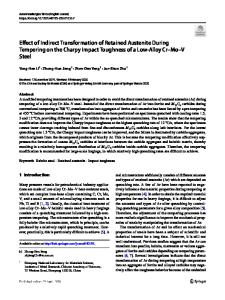Effect of processing on Charpy impact toughness of metallic glass matrix composites
- PDF / 783,260 Bytes
- 9 Pages / 584.957 x 782.986 pts Page_size
- 61 Downloads / 348 Views
Henry Kozachkov, Scott Roberts, and Georg Kaltenboeck California Institute of Technology, Pasadena, California 91126
Robert D. Conner California Institute of Technology, Pasadena, California 91126; and California State University—Northridge, Northridge, California 91330
Marios D. Demetriou and William L. Johnson California Institute of Technology, Pasadena, California 91126
Douglas C. Hofmanna) Jet Propulsion Laboratory/California Institute of Technology, Pasadena, California 91109; and California Institute of Technology, Pasadena, California 91126 (Received 15 December 2010; accepted 14 March 2011)
In this study, compact Charpy impact testing was used to investigate the effect of processing history and dendrite morphology of bulk metallic glass matrix composites (BMGMCs) on impact toughness. Composite samples were fabricated via suction casting and semisolid forging, and the results were compared with crystalline alloys in the same geometry. A strong dependence on processing was observed, with samples exhibiting up to a 30-fold increase in impact toughness depending on processing and microstructure. Provided that attention is paid to processing techniques, BMGMCs are shown to have properties that equal or surpass some conventionally used crystalline alloys. These properties invite further exploration of these materials in structural applications.
I. INTRODUCTION
Bulk metallic glasses (BMGs) are a relatively new class of engineering metals that have been widely investigated as potential high-performance materials for a variety of applications, from bulk structural hardware to microelectromechanical systems (MEMS).1–6 Unfortunately, BMGs have been underutilized in high performance structural applications due to their abrupt failure in unconfined loading, their low fracture toughness, and low fatigue limit.7–9 Recently, significant progress has been made toward toughening BMGs by developing a series of ductile phase-reinforced BMG matrix composites (BMGMCs), which combine soft crystals (usually body-centered cubic) with a metallic glass matrix.10–17 Although these BMGMCs first emerged a decade ago, a correlation between processing and mechanical performance was not realized until recently.12,13 When cast from the liquid, BMGMCs exhibit a wide range of dendrite morphologies that develop as a result of thermal gradients during cooling. By processing the composites below the liquidus temperature, in the semisolid two-phase region, a more uniform microstructure can be obtained. It has been a)
Address all correspondence to this author. e-mail: [email protected] DOI: 10.1557/jmr.2011.92 1260
J. Mater. Res., Vol. 26, No. 10, May 28, 2011
http://journals.cambridge.org
Downloaded: 09 Apr 2015
demonstrated that the length scale associated with the dendrites is directly related to the fracture toughness of the composites. For example, a BMGMC, termed LM2 (Zr56.2Ti13.8Nb5.0Cu6.9Ni5.6Be12.5), cast from the liquidus exhibited a plane strain fracture toughness of K1C 5 31 MPa m1/2 (Ref. 18), which represents a twofold improv
Data Loading...











